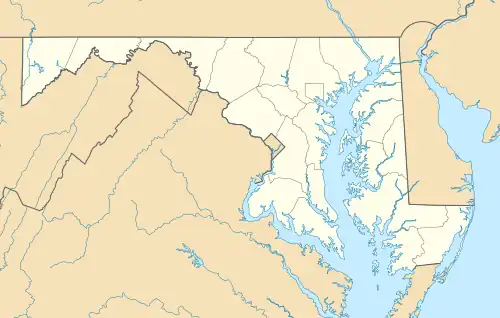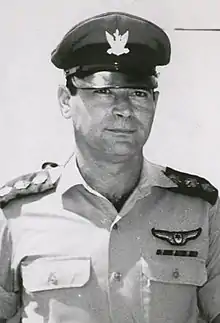Chevy Chase, Maryland
Chevy Chase (/ˈtʃɛviː tʃeɪs/) is the name of both a town and an unincorporated census-designated place (Chevy Chase (CDP), Maryland) that straddle the northwest border of Washington, D.C., and Montgomery County, Maryland, United States. Several settlements in the same area of Montgomery County and one neighborhood of Washington include Chevy Chase in their names. These villages, the town, and the CDP share a common history and together form a larger community colloquially referred to as Chevy Chase.
Chevy Chase, Maryland | |
|---|---|
 The former 4-H Youth Conference Center, which is to be redeveloped into senior housing | |
 Chevy Chase Location of Chevy Chase in the U.S. state of Maryland  Chevy Chase Chevy Chase (the United States) | |
| Coordinates: 38°58′16″N 77°04′35″W | |
| Country | |
| State | |
| County | Montgomery |
Primarily a residential suburb, Chevy Chase adjoins Friendship Heights, a popular shopping district. It is the home of the Chevy Chase Club and Columbia Country Club, private clubs whose members include many prominent politicians and Washingtonians.[1]
Chevy Chase was noted as "the most educated town in America" in a study conducted by the Stanford Graduate School of Education, with 93.5 percent of adult residents having at least a bachelor's degree.[2]
The name Chevy Chase is derived from Cheivy Chace, the name of the land patented to Colonel Joseph Belt from Charles Calvert, 5th Baron Baltimore, on July 10, 1725. It has historic associations with a 1388 chevauchée, a French word describing a border raid, fought by Lord Percy of England and Earl Douglas of Scotland over hunting grounds, or a "chace", in the Cheviot Hills of Northumberland and Otterburn.[3] The battle was memorialized in "The Ballad of Chevy Chase".
History
19th century
In the 1880s, Senator Francis G. Newlands of Nevada and his partners began acquiring farmland in unincorporated areas of Maryland and just inside the District of Columbia, for the purpose of developing a residential streetcar suburb for Washington, D.C., during the expansion of the Washington streetcars system. Newlands and his partners founded The Chevy Chase Land Company in 1890, and its holdings of more than 1,700 acres (6.9 km2) eventually extended along the present-day Connecticut Avenue from Florida Avenue north to Jones Bridge Road.
Newlands, an avowed white supremacist, and his development company took steps to ensure that residents of its new suburbs would be wealthy and white;[4] for example, "requiring, in the deed to the land, that only a single-family detached house costing a large amount of money could be constructed. The Chevy Chase Land Company did not include explicit bars against non-white people, known as racial covenants, but the mandated cost of the house made it impractical for all but the wealthiest non-white people to buy the land." Houses were required to cost $5,000 and up on Connecticut Avenue and $3,000 and up on side streets.[5] The company banned commerce from the residential neighborhoods.[6]
Leon E. Dessez was Chevy Chase's first resident. He and Lindley Johnson of Philadelphia designed the first four houses in the area.[7]
Toward the northern end of its holdings, the Land Company formed a manmade lake, called Chevy Chase Lake, to produce hydroelectric power for its streetcars, and provide a venue for boating, swimming, and other activities.[8] The streetcar soon became vital to the community; it connected workers to the city, and even ran errands for residents.
Part of the original Cheivy Chace patent had been sold to Abraham Bradley, who built an estate known as the Bradley Farm.[9] In 1892, Newlands and other members of the Metropolitan Club of Washington, D.C., founded a hunt club called Chevy Chase Hunt, which would later become Chevy Chase Club. In 1894, the club located itself on the former Bradley Farm property under a lease from its owners. The club introduced a six-hole golf course to its members in 1895, and purchased the 9.36-acre Bradley Farm tract in 1897.[10][9][11]
20th century
In 1906, the Chevy Chase Land Company blocked a proposed subdivision called Belmont after they learned its Black developers aimed to sell house lots to other African Americans. In subsequent litigation, the company and its affiliates argued that those developers had committed fraud by proposing "to sell lots...to negroes."[12]
By the 1920s, restrictive covenants were added to Chevy Chase real estate deeds. Some prohibited both the sale or rental of homes to "a Negro or one of the African race." Others prohibited sales or rentals to "any persons of the Semetic [sic] race"—i.e., Jews.[12]
By World War II, such restrictive language had largely disappeared from real estate transactions, and all were voided by the 1948 Supreme Court decision in Shelley v. Kraemer.
In 1964, Arthur Krock wrote an article for The New York Times alleging that the Chevy Chase Country Club barred "Negroes" and "one ethnic group of Caucasians" from membership. In response, Club president Randall H. Hagnar denied that the club excluded Black or Jewish people; he said that no members were African-Americans but that several were Jewish.[13]
Lea M. Bouligny founded the Chevy Chase College and Seminary for Young Ladies at the Chevy Chase Inn, located at 7100 Connecticut Avenue). The name was changed to Chevy Chase Junior College in 1927. The National 4-H Club Foundation purchased the property in 1951,[14] turning it into the group's Youth Conference Center. For decades, the center hosted the National 4-H Conference, an event for 4-Hers throughout the nation to attend, and the annual National Science Bowl in late April or early May.[15]
21st century
The National 4-H Club Foundation sold the center in 2021 for $40 million; as of 2022, it is to be replaced by a senior living development.[16]
Subdivisions
- Census-designated place of Chevy Chase
- Incorporated town of Chevy Chase
- Chevy Chase (Washington, D.C.)
Villages
- Chevy Chase Village, Maryland
- Chevy Chase Section Three, Maryland
- Chevy Chase Section Five, Maryland
- Martin's Additions, Maryland
- North Chevy Chase, Maryland
In addition to the Maryland villages listed above, the United States Postal Service uses Chevy Chase for some postal addresses that lie outside historical Chevy Chase: in Somerset, the Village of Friendship Heights, and the Rock Creek Forest area, east of Jones Mill Road and Beach Drive and west of Grubb Road.
Education
Chevy Chase is served by the Montgomery County Public Schools. Residents of Chevy Chase are zoned to Somerset, Chevy Chase or North Chevy Chase Elementary School, which feed into Silver Creek Middle School, Westland Middle School and Bethesda-Chevy Chase High School. Private schools in Chevy Chase include Concord Hill School, Oneness-Family School, and Blessed Sacrament School.
Rochambeau French International School formerly had a campus in Chevy Chase.[17]
Retail
For decades, a six-block stretch of Wisconsin Avenue in Friendship Heights and Chevy Chase contained the only concentration of traditional department stores at least partially in Washington, D.C. Two of these closed in 2020: the Lord & Taylor and Neiman Marcus stores, both of which were in D.C.[18] As of 2022, two department stores remain, both on the Maryland side: a freestanding Saks Fifth Avenue and a Bloomingdale's in Wisconsin Place, which also includes a Whole Foods Market, boutiques, and residential and office space.
The D.C. portion of the stretch includes these shopping centers:
- Friendship Center, with big-box discount retailers Marshalls and DSW
- Chevy Chase Metro Center, with big-box craft retailer Michaels
- Chevy Chase Pavilion, whose Cost Plus World Market and Old Navy closed in 2020.[19]
On the Maryland side is The Collection at Chevy Chase, an upscale center that includes a Tiffany & Co. location.
Notable people
Current residents
- Ann Brashares – author[20]
- John Carlson – professional ice hockey player[21]
- Marvin Kalb – journalist[20]
- Brett Kavanaugh – associate justice, United States Supreme Court
- Tony Kornheiser – television host, currently ESPN employee presenter
- Howard Kurtz – host of Fox News program Media Buzz
- Collin Martin – soccer player
- Chris Matthews – commentator
- Jerome Powell – current Chairman of the Federal Reserve
- John Roberts – Chief Justice of the United States[20]
- A. B. Stoddard – political commentator and editor of RealClearPolitics
- George Will – conservative commentator[20]
Former residents
- Yosef Alon – Israeli Air Force officer
- Jamshid Amouzegar – former prime minister of Iran
- Tom Braden – journalist and author[22]
- David Brinkley – journalist[22]
- John Charles Daly – media personality
- Mark Ein – venture capitalist and sports team owner[23]
- Bill Guckeyson – athlete and military aviator
- Josh Harris – investor and sports team owner[23]
- Ed Henry – journalist
- Richard Helms – former director of the Central Intelligence Agency
- Genevieve Hughes – one of the 13 original Freedom Riders[24]
- Hubert Humphrey – politician[22]
- Gayle King – television anchor
- Ted Lerner – owner of Lerner Enterprises and the Washington Nationals
- Anthony McAuliffe – US general
- Sandra Day O'Connor – United States Supreme Court Justice[22]
- Hilary Rhoda – model[25]
- Nancy Grace Roman – former NASA executive
- Peter Rosenberg – media personality[26]
- Danny Rubin – basketball player[27]
- Mark Shields – political columnist[20]
- Karl Truesdell – US Army major general[28]
References
- "Obama to Join Maryland Country Club". Washingtonian. 2017-10-06. Retrieved 2020-01-09.
- "Affluent Md. suburb named nation's most educated". WTOP. 2015-01-07. Retrieved 2020-01-09.
- "The Naming of Chevy Chase". Chevy Chase Historical Society.
- Flanagan, Neil (2017-11-02). "The Battle of Fort Reno". Washington City Paper. Retrieved 2022-05-27.
- Ohmann, Richard Malin (1996). Selling Culture: Magazines, Markets, and Class at the Turn of the Century. Verso.
- Dryden, Steve (1999). "The History of Chevy Chase and Friendship Heights". Bethesda Magazine.
- Benedetto, Robert; Donovan, Jane; Vall, Kathleen Du (2003). Historical Dictionary of Washington. Scarecrow Press. p. 53. ISBN 9780810840942.
- "The History of Chevy Chase and Friendship Heights". Bethesda Magazine. September 27, 2010. Retrieved October 24, 2018.
- "The Naming of Chevy Chase | Chevy Chase Historical Society". www.chevychasehistory.org. Retrieved 2018-10-24.
- Early Days at the Chevy Chase Club, The Montgomery County Story, Montgomery County Historical Society, November 2001
- "Chevy Chase Club - Club History". www.chevychaseclub.org. Retrieved 2018-10-24.
- Fisher, Marc (February 15, 1999). "Chevy Chase, 1916: For Everyman, a New Lot in Life". The Washington Post.
- "Chevy Chase Country Club Denies Excluding Jews from Membership". Jewish Telegraphic Agency. Retrieved 2023-06-20.
- "The Schools of Section Four - Chevy Chase Historical Society". Chevy Chase Historical Society.
- "U.S. Department of Energy, Office of Energy, National Science Bowl®". United States Department of Energy.
- Schere, Dan (2021-12-21). "Sale of 4-H site in Chevy Chase finalized for $40 million". Bethesda Magazine. Retrieved 2022-04-19.
- "Contacts". Rochambeau French International School. Archived from the original on 2000-01-23. Retrieved 2023-01-25.
- https://planning.dc.gov/sites/default/files/dc/sites/op/publication/attachments/Friendship%2520Heights.draft%2520final.pdf
- https://www.popville.com/2020/12/friendship-heights-is-looking-more-and-more-bare/
- Neate, Rupert (December 4, 2015). "Chevy Chase, Maryland: the super-rich town that has it all – except diversity". The Guardian.
- Hull, Steve (July 23, 2018). "Washington Capitals' John Carlson Buys Home in Chevy Chase". Bethesda Magazine.
- "Bethesda, Chevy Chase Homes of The Rich and Famous". Bethesda Magazine. October 10, 2012.
- Elfin, David (July 6, 2015). "Q&A with the Owners of the Philadelphia 76ers, New Jersey Devils and Washington Kastles". MoCo360. Archived from the original on March 22, 2023. Retrieved March 22, 2023.
- Arsenault, Raymond (2006), Freedom Riders: 1961 and the Struggle for Racial Justice, Oxford: Oxford University Press, ISBN 9780199755813
- "Hilary Rhoda - Fashion Model - Profile on New York Magazine". New York.
- Richards, Chris (May 31, 2013). "Peter Rosenberg: From Montgomery County to top of the hip-hop heap". The Washington Post.
- Giannotto, Mark (February 4, 2011). "Danny Rubin goes from Landon to Boston College walk-on to ACC starter". The Washington Post.
- "Obituaries: Maj. Gen. Karl Truesdell". Chicago Tribune. Chicago, IL. Associated Press. July 18, 1955. p. F6 – via Newspapers.com.

